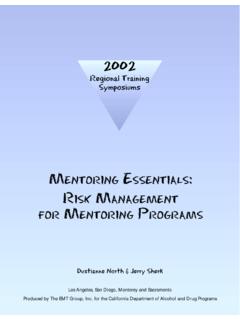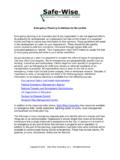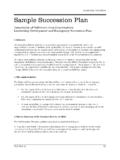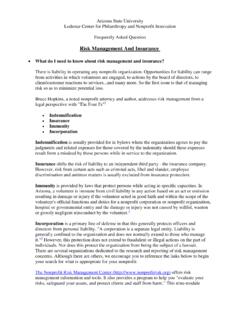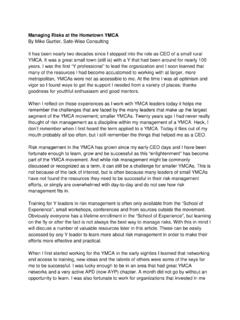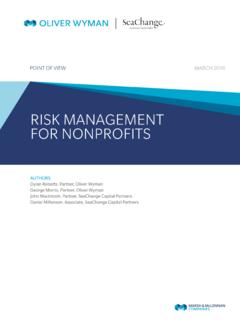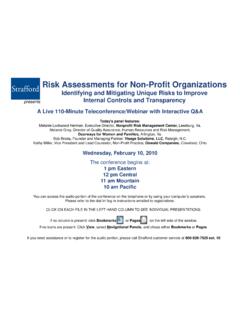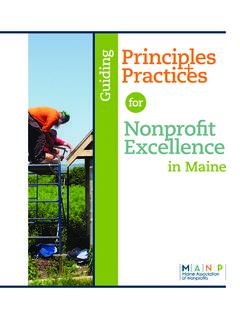Transcription of BASIC RISK MANAGEMENT FOR NOT-FOR-PROFITS
1 BASIC RISK MANAGEMENT FOR NOT-FOR-PROFITS This document is designed to make it easy for you to get a very BASIC , practical risk MANAGEMENT strategy in place. WHERE TO START Most NFP organisations acknowledge that good risk MANAGEMENT practices are important. The problem is that most also believe it is too complex, too time consuming and there are other more important priorities. Others have folders of policies and procedures that sit nicely on the top shelf gathering dust. The 2010 PPB not-for-profit risk survey revealed that a majority of organisations do not have adequate risk MANAGEMENT practices.
2 This document is designed to try to make it easy for you to get a very BASIC , practical risk MANAGEMENT strategy in place. WHAT IS A RISK? We deal with risks every day. For example, getting in the car to drive has risks . risks are a part of life, and in fact very much part of any organisations activities. To define risk on a technical level, a risk is the effect of uncertainty of an object . Think of it as cause and an event happens (the cause) and the risk is the effect (good or bad) and how likely it will happen. A risk can be internal (within your control) or external (outside your control).
3 Risk MANAGEMENT then, is managing the possibility that something will happen. WHAT IS THE RISK MANAGEMENT PROCESS? The 5 Step Process is based on Australian Standards. While you can take this amazing depth and complexity, for most small organisations, keeping it simple is the key. STEP 1 - Identify your risks . STEP 2 Analysis your risks STEP 3 - Evaluate your risks STEP 4 Treat your risks STEP 5 Monitor and review the risks STEP 1 - IDENTIFY YOUR risks Identifying risks is usually a simple brainstorming exercise. It is best done by leaders with operational responsibility as they best know the practical aspects of any risk.
4 Getting an external or independent perspective will also ensure that you don t miss critical risks from being too close to the activity to be objective. The following is a broad guide of internal and external risks to consider. Financial Accounting Standards Interest rates Taxation & Government Donor health Board Experience / skills Marketplace risks Economic Environment Opposing Parties Competition Technology / Marketing Brand & Reputation risks Community Perception Competitor action Regulatory Major event failure Infrastructure risks Natural Disasters Pandemic & terrorism Suppliers Communications Legal / regulations Financial Infrastructure Accounting Standards People Volunteers & staff Debt / Credit Health & Safety Expense
5 MANAGEMENT Property Tax & Govt IT Systems Marketplace Brand & Reputation Accountability Controls Sub Brands Intellectual Property Board Composition Contracts / legal Accountability Controls Alliances Risk tolerance External risks Internal risks Identify your risk External risks STEP 2 ANALYSE YOUR RISK Once you have created your list of risks , you need to do a simple exercise of systematically determining how important these risks are. Following is a universal table which helps you to rank the risks based on the likelihood of occurrence and then just how much impact the event would have on your organisation.
6 STEP 3 - EVALUATE YOUR RISK Step 3A: Once you have a list of analysed risks , its time to prioritise them. Rank the risks in order of the highest risks to lowest. At this point many organisations get overwhelmed and give up. We recommend that you select the top 6-10 risks to start with. It is better to deal with the most important risks properly first, then move on to the other lower priority risks . Step 3B: The next practical step is to evaluate your top risks by asking a simple question, Are we comfortable with the way this risk is being handled? Step 3C: It s now time to complete a simple summary document of your risk MANAGEMENT findings.
7 This summary is commonly referred to as a risk register. The following is an example of a risk register. InsignifcantMinorModerateMajorCatastroph icAlmost CertainHHERERERL ikelyMHHERERP ossibleLMHERERU nlikelyLLMHERRareLLMHHER = Extreme Immediate action required to eliminate or reduce riskH = HighSenior MANAGEMENT attention neededM = Moderate Action must be taken to eliminate or reduce the riskL = LowManaged by routine proceduresRISK RATINGP riorityRiskDetailsLikelihood Consequence Risk RatingTreatmentBy whomBy when1 Damage to reputationAllegation of improprietyPossibleMajorERDevelop HR protocols Appoint PR agencyHR Manager 15-Dec-102 Employment issueStaff member unfair
8 DismissalUnlikelyModerateModerateDevelop HR protocolsHR Manager30-Jan-113 Major building fireFire causing complete loss of buildingUnlikelyMajorHighCreate continuity plan. Review fire safety proceduresMD30-Jan-114 Loss of major donorDonor withdraws annual supportLikelyMajorERDevelop major donor strategy. MD15-Dec-115 Board changeKey board member retiresLikelyMinorHighCreate board succession planBoard20-Mar-11 RISK REGISTER (Example) STEP 4 TREAT YOUR RISK There are four things you can do about a risk. The strategies are: Avoid the risk. Do something to remove it such as ban the activity.
9 Transfer the risk. Make someone else responsible. Perhaps engage a contractor or a third party. Getting appropriate insurance coverage may be a risk transfer strategy. Mitigate the risk. Take actions to lessen the impact or chance of the risk occurring. Create risk strategies, plans and policies for risks and adjust behaviours where necessary to reduce the risk. Accept the risk. You might calculate the risk and decide that it is worth taking on for yourself. STEP 5 MONITOR AND REVIEW YOUR risks Every organisation, big or small, should allocate one or two people to champion and manage the risk MANAGEMENT process.
10 They should provide regular reports to the board as well as coordinate the assessment of any new activities. It is appropriate to conduct a comprehensive review annually and looking at any incident and near miss trends. It is best to schedule in advance. COMMON NOT-FOR-PROFIT risks Common NFP risks to consider (in no particular order) are: People risks : Including public safety, child safety and youth activities, sexual and physical assaults. Events MANAGEMENT : Running public access fundraisers have their own risks . Be sure to create a risk plan for each event to understand your risks .
